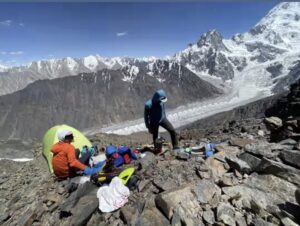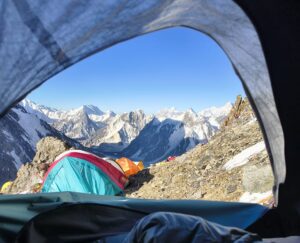Dramatic events have kept our attention on Broad Peak for the last four days. Further details have emerged, others will surely come. Here is what we know so far about the summit climb and the accident that led to the death of Kim HongBin.
July 17: First attempt fails
The first summit attempt failed because of the slow pace through the waist-deep snow. Karakorum Expedition’s leader Mirza Ali praised Don Bowie and Lotta Hintsa for their efforts but mentioned that many others refused to help. In the end, all climbers had to retreat to Camp 3 after a huge effort.
Later that day, Mustapha, a high-altitude porter with the Belgian team, became sick and needed help to get back down alive. He made it, although that ended the summit attempt of those who helped him.
“We left at midnight with half the manpower we were supposed to have, as people who had committed to helping decided to sit back,” Lotta Hintsa said after returning to Base Camp. “Mirza Ali’s fixing team took the lead and I, Hugo, and Nils helped [as much as] we could, navigating deep snow and a sea of crevasses. Some hours later, two more climbers showed up to help too.”

The huge crevasse (or one of them) on the way to the saddle of Broad Peak. Photo: Israfil Ashurli
That day, the trail-breakers reached what has proved a key spot this season: a huge crevasse that, according to Hintsa, cut off the route at 7,750m. Upon reaching it on July 17, “porters decided to go down, but four of us tried to proceed,” she said. “We found a sketchy alternative route and tried to climb higher, but It took us 45 minutes to climb just 20-30m. The snow just collapsed underneath…So we turned around, feeling good and only 300m to go to the summit…It sucks.”
Hintsa returned to a Camp 3 “full of climbers waiting to go up the next day”. Then Don Bowie sent an SOS calling for volunteers to help the ailing Mustapha.
“Everyone pretended they didn’t hear”
Dehydrated, hungry, and exhausted from lack of sleep, Lotta Hintsa asked around if anyone could go and help. “But everyone pretended they didn’t hear,” she said, “so I packed my huge pack (no one was willing to lend their tent for a deposit either) and started going down. Belgian Jeff [Spelmans] came after me and took over the rescue: enormous respect!!”
Spelmans’ teammate Sophie Lenaerts confirmed this. She added that her team gave Mustapha oxygen, while the Russians gave him dexamethasone. Meanwhile, Mirza Ali continued to coordinate the rescue with the liaison officer.

Lotta Hintsa didn’t summit but helped open the way for many others. Photo: Don Bowie
The British team (“Cumbria to Broad Peak”) says that on July 17, they had to help with “several emergency rescues”, since they were among the only climbers high on the mountain after the failed mass summit attempt and retreat earlier that day.
“This compromised their summit attempt, but life and preserving life is far more important to these two men,” their home team posted on social media. But then they announced that the climbers would try again to summit a few days later.
Meanwhile, the Korean team (six Koreans plus supporting staff) led by Kim HongBin set up Camp 4.
July 18: First (main?) summits
Despite conditions, the Karakorum Expedition rope fixers and many climbers headed back toward the top. This time, they succeeded.
Oswald Rodrigo Pereira, who had also tried the day before, was among them. After more than 10 hours of hard work the previous day, he didn’t believe that he could put in that much effort again.
“But in fact, that’s what happened,” Pereira wrote. “We woke up in the middle of the night and we used fixed ropes until some point, but the last hours were ‘quite alpine style.’ ” Hugo Ayaviri of Bolivia and Niels Jespers of Belgium accompanied him.

Oswald Rodrigo Pereira on the summit of Broad Peak. Photo: Oswald Rodrigo Pereira
“The three of us made it to the summit at 3:15 pm, without oxygen and after two days of incredibly hard work, and we were the first ones of the season,” Pereira wrote.
The rope-fixing team reached the top shortly after: Jalal Uddin, Eid Muhammad, and Faryad Karim. Mirza Ali also lists the following summiters: Fahad Badar from Qatar, Saeed Al Memari from the UAE, Pakistanis Bulbul Karim, Ilyas (no surname mentioned), Inayat Ali, and IFMGA guide Stefan Keck. We’ll add more names in the future, as they become known.
Sophie Lenaerts admitted that she and partner Stef Maginelle only reached a sub-summit of Broad Peak but didn’t continue to the main summit with teammate Niels Jespers.

Climbers near the summit of Broad Peak. Photo: Sophie Lenaerts
Slow going, then a technical section
Lenaerts says that a large group of climbers, many with supplementary O2, slowed down the pace. She and Maginelle were not able to go around them because of the deep snow, which kept everybody on a single track.
At the saddle, one-third of those on the collective push abandoned the attempt. A rather technical section followed: “First, one must traverse a narrow rock passage where the cornice turns out not to be solid at all,” she said. “This is where Mr. Kim fell.
“Then a short traverse on rocks, no room for mistakes…and then it’s a find-your-way, up and down several times, before reaching [a sub-summit],” Lenaerts added.
It was around 4.30 pm before she stepped onto the point would serve as her summit. “It was time to return,” she said. “We still had a long way to go but it was all worth it!”

Sophie Lenaerts and Stef Maginelle soaking in the views from near the top of Broad Peak. Photo: Sophie Lenaerts
Azerbaijan’s Israfil Ashurli also reported on the exposed climb to get to the saddle and along the ridge. “I climbed 8-10m of mixed climbing on the couloir that grants access to the ridge,” he wrote. “It’s scary to look at the Chinese side: vertical cornices breaking [away]. I preferred to bypass that section by climbing on the rocks to the right rather than to step onto the snow, which guarantees a high-speed voyage to China.”
Ashurli, who had suffered stomach problems in Camp 3, turned around in the end. He hopes to give Broad Peak a second try during the next good weather window.

“Rock climbing at 8,000m,” says Saulius Damulevicius.
Anastasia Runova of Russia and Saulius Damulevicius of Lithuania reached the top quite late in the day, according to some reports. However, Damulevicius himself has just posted that he didn’t summit.
When climbers share details in the days ahead, it is worth noting who used O2 and who else stopped below the main summit. Lenaerts and Maginelle have already been listed as “summiters” in some reports.
Monika Witkowska of Poland had to turn around when her O2 system failed. On the way down, she fell and slid down some 100m. She was unharmed and continued down on her own.
The Deathzone Freeride members Vitaly Lazo and Anton Pugovkin eventually turned back too. It was late in the day, and snowfall was increasing. They reached Camp 3 at around 10 pm and fell asleep right away. But not for long.

Death Zone Freeride members Anton Pugovkin and Vitaly Lazo. Photo: Anna Piunova
July 19: Tragedy strikes
The Russian skiers helped in two rescues of descending climbers. First, Anastasia Runova fell and lost her crampons in the process. Apparently, she was still coming down from a very late summit. Lazo and Pugovkin helped her and treated her in Camp 3.
Later, a second SOS put the Russians on the move again. Kim HongBin had fallen somewhere and was unreachable. Lazo took some oxygen and hurried up to the site of the accident, Pugovkin reported. However, all efforts were fruitless and Kim died.
The climbers who were with Kim and Runova, including Lazo and Pugovkin, will have to clarify the exact times and locations of the accidents. Early reports, posted by Pugovkin in Russian, suggested that Kim might have fallen into a crevasse. However, Sophie Lenaerts describes a different scenario in her own report and gave some details to ExplorersWeb.
“Both Anastasia and Mr. Kim fell at the same place: down a cornice above the saddle, on the summit ridge,” she explained. This was precisely where Lenaerts and Ashurli mentioned that the route became exposed and “scary”.
“Nastya [Anastasia] is okay,” Lenaerts said. “She got out of her difficult situation by herself. Because of her being stuck, Kim decided to take another rope that was in bad condition. He fell and stopped on a ledge [15m below, according to some reports]. With his handicap, he was not able to get out.”

Because of the loss of all his fingers, Kim climbed with adaptive tools that would have not been with him during his descent.
Kim was still alive
Salius Damulevicius mentioned in his own report that Kim summited Broad Peak at 5 pm, only two hours before dark. After he fell, Damulevicius went on, Kim “stayed all night on a ledge on the Chinese side, where Broad Peak’s wall falls all the way down to the glacier. Nastya Runova fell there and was rescued by a Pakistani guide, but Mr. Kim for some reason [was] not.”

Exposed passage near the summit of Broad Peak. Photo: Saulius Damulevicius
That Kim remained there all night is coherent with the time that Pugovkin reported the attempted rescue on the following day. We don’t know whether Kim’s team was with him when he fell and how they tried to help. The state of the fallen climber is also unknown.
Lenaerts had no details about the rescue since she was not present. So far, there have only been some brief reports in Russian, especially by journalist Anna Piunova. According to her, Lazo went to help the Korean at about 3 am and found Mr. Kim alive on the ledge.
Apparently, Lazo tried unsuccessfully to drag him back up the ridge and remained with him all night. Piunova also mentions that a helicopter was considered, but Kim had no helicopter rescue insurance. Eventually, Pugovkin decided to join Lazo at the accident site. But Piunova posted that around noon, “The Korean could not be saved. He fell.
The weather [was] getting worse.”
Few people are willing to discuss the incident, so this somewhat unclear timeline is currently the best that we have. But it does appear that Kim was alive for several hours after his accident.
K2 and second chances on Broad Peak
Lenaerts and Maginelle are not going to K2 but their teammates Niels Jespers and Jeff Spelmans will. Luc Beirinckx and Wouter Noterman, who retreated when Mustapha fell sick, will make a second attempt on Broad Peak.
Climbers managed to return to Base Camp throughout the day. The weather is currently bad and should remain so for the next couple of days.
Akhbar Syed told ExplorersWeb that another good weather window is coming. It should last from July 22 until July 26-27. “But you know,” he added, “the Karakorum is always unpredictable.”




